Employees often struggle to obtain organizational information.
Have you ever forgotten about a company event? How often do you contact IT regarding equipment setup? Do you know who your point of contact is in other teams?
If you find yourself asking these questions, you’re not alone.
However, an internal knowledge base would help you find answers to most of them, without having to resort to asking your co-workers.
A centralized repository of company intelligence, knowledge bases facilitate knowledge-sharing, allowing employees to find the information they need immediately.
And that’s only one upside to internal knowledge bases; these systems come with countless other benefits. To find out what they are, keep on reading!
Internal Knowledge Preservation
Your employees might not stay with your company.
Circumstances change; one team member might relocate, another could embark on a career change; there are countless such possibilities.
However, this attrition might be more damaging than you think.
Matthew Loxton, the principal analyst at Whitney, Bradley & Brown, explains why:

Illustration: Archbee / Source: Matthew Loxton’s KM and OL blog
If your employees leave, you don’t just lose manpower—you also lose their knowledge.
This is a significant issue, as each team member possesses unique insights that benefit the company.
For instance, if your only technical writer leaves, who will teach their replacement about your documentation’s information architecture?
Who else understands all the features of your documentation tool?
While you can hire someone with similar skills, there’s no replacing the extensive implicit company knowledge a long-standing employee amasses.
Such individuals are invaluable assets.
Consequently, Carol Kinsey Goman, Kinsey Consulting Services President, defines knowledge management as follows:

Illustration: Archbee / Source: SHRM
High-quality knowledge management empowers high-quality change management.
With a sophisticated knowledge-sharing strategy, you can ensure old employees’ knowledge is communicated to other team members.
An integral part of this strategy is developing an internal knowledge base, as these resources can easily preserve such critical internal knowledge.
Here are a few examples of information you can retain with your internal knowledge base:

Source: Archbee
All these areas can be thoroughly documented in your knowledge base, conserving the information indefinitely.
Even small contributions to these topics are hugely helpful.
Imagine your technical writer documents the code review procedure or lists some inspiring conferences they’d attended. Outlining common IT issues is also useful.
In these examples, you instantly have access to specialized, specific knowledge that could have easily been lost.
However, with the help of your knowledge base, this intelligence is easily preserved.
Faster Onboarding of New Employees
When a new addition joins your team, you can’t just drop them off at their desks, hand them a laptop and expect quality work. They’d have no idea where to even begin.
New employees need to be onboarded into your organization; slowly introduced to your processes, procedures, and policies.
They require support to integrate into your company culture.
However, unfortunately, such proactive onboarding is rarely provided. A recent survey revealed the following findings:

Illustration: Archbee / Source: Panopto
Most new employees spend over a quarter of their workweek asking others for help. Not only is this not an efficient use of their time, but it also slows down your other employees’ workload.
Ari Bixhorn, Head of Marketing at Convoy, was understandably critical of such situations:
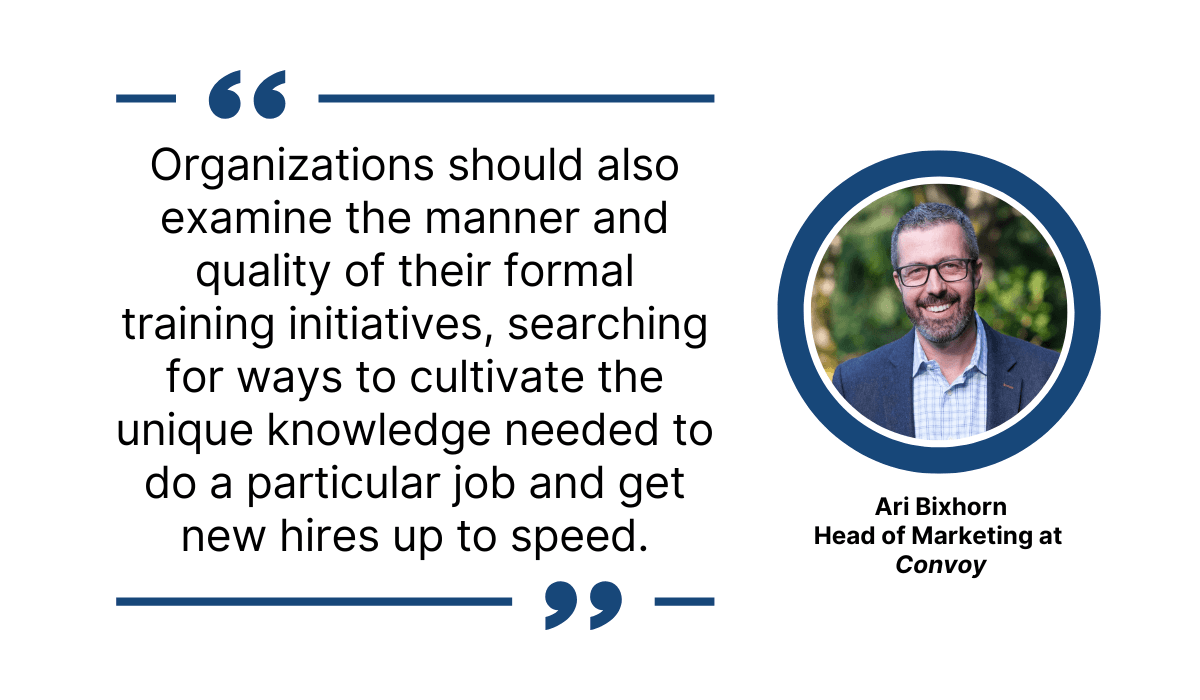
Illustration: Archbee / Source: HR Daily Advisor
In other words, there must be some more effective onboarding practices than newcomers constantly asking your other employees questions.
One such alternative method is leveraging your internal knowledge base.
With an extensive knowledge base, your new hires’ inquiries can be redirected to this informational repository.
They won’t have to consult other team members but can onboard themselves by reading the knowledge base articles.
After all, such resources should be chock-full of information helpful for your new employees.
Ideally, your internal knowledge base should contain the following documents:
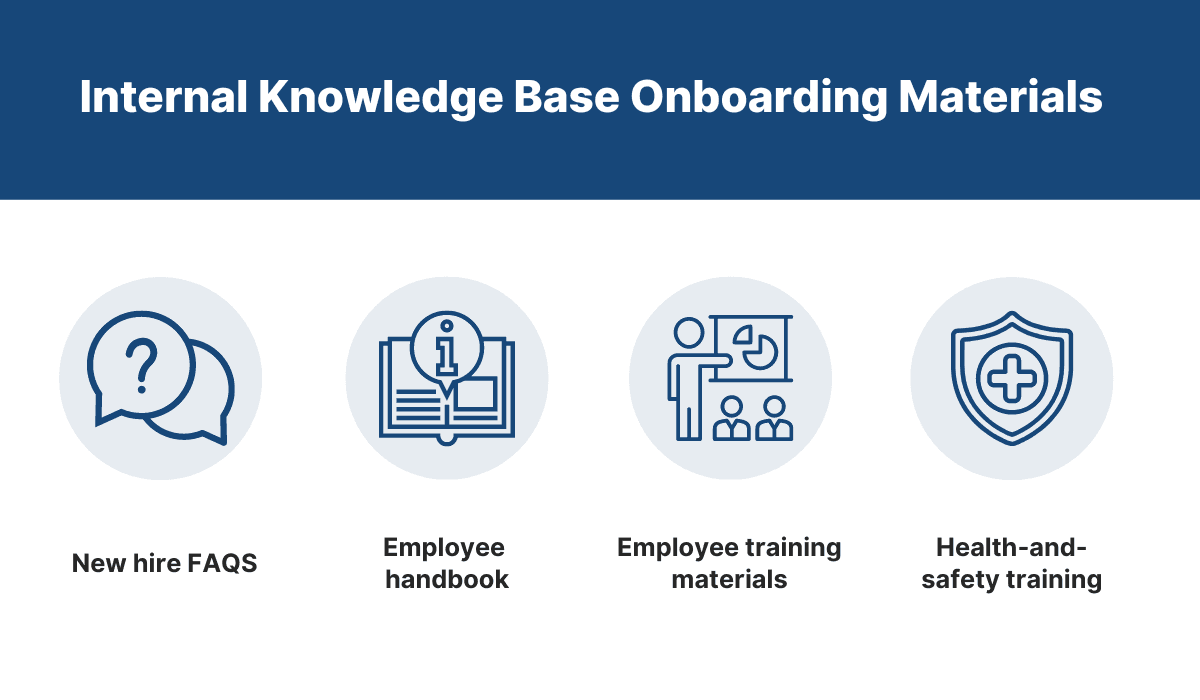
Source: Archbee
Ensure to include these sections in your internal knowledge base, as new employees can onboard themselves faster with such materials.
The FAQs provide a quick reference point for any questions, whereas the employee handbook offers more in-depth information on company policies.
It’s also worth composing training materials, as newcomers can quickly educate themselves.
Inserting these resources in an internal knowledge base allows information to be accessed by newcomers whenever they need it, meaning their onboarding process should be significantly accelerated.
Improved Employee Engagement
If your employees are invested in the company’s success, passionate about its growth, and taking an active role, consider yourself fortunate—you’ve got fully engaged team members.
However, unfortunately, such team members are rare nowadays, as per Gallup’s findings:

Illustration: Archbee / Source: Gallup
The majority of the workforce is indifferent toward their employment, simply going through the motions at work. They aren’t inspired and can’t work at their full potential.
One possible contributing factor to this disengagement is the following insight:
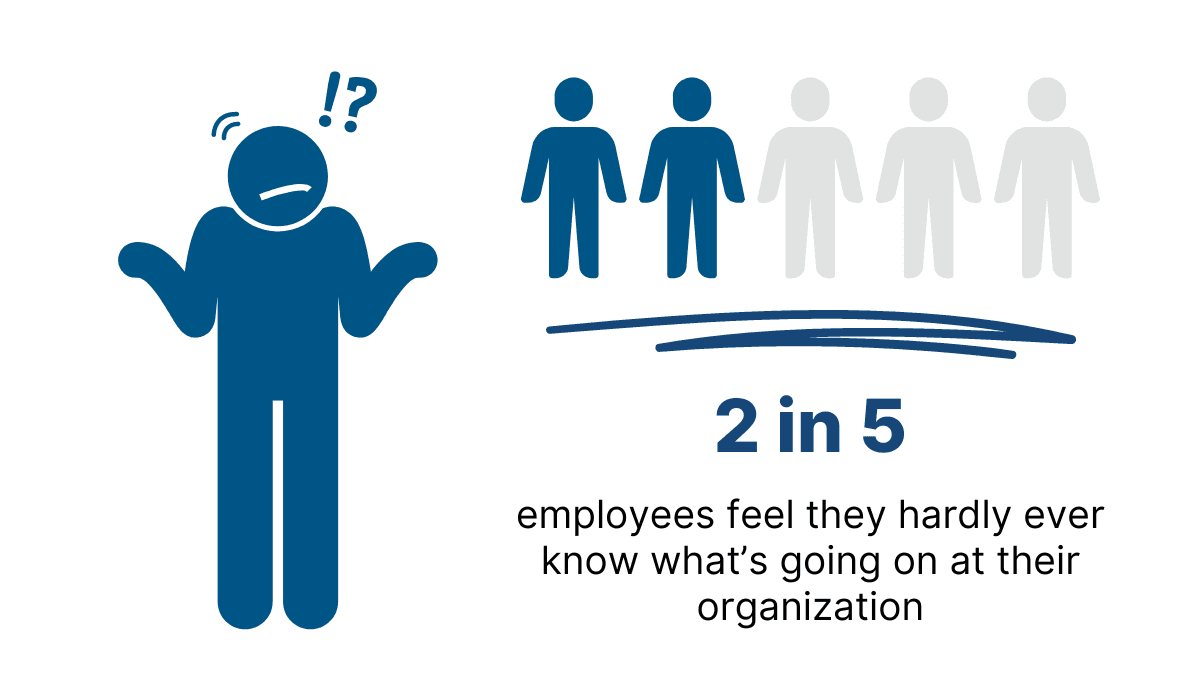
Illustration: Archbee / Source: AMA
Employees often feel out of the loop.
Many are unsure how their work contributes to the company’s business plan, and the firm’s general direction and high-level goals are often a mystery.
Such detachment from the big picture often causes disengagement. After all, why would employees care about an organization they don’t know anything about?
This is why an internal knowledge base is crucial—you can use it to explain your employees’ role in the company’s success.
For example, highlight how your developers built a feature the stakeholders loved or praise the Sales team for attaining a new client.
Give your team members concrete examples of how their efforts paid off.
Such information should invigorate them and drive them to contribute further to the company.
Jason McPherson, the Chief People Scientist at Culture Amp, also commented on this:

Illustration: Archbee / Source: Forbes
By communicating how your employees advance the company’s progress, you’re sure to inspire your team members and drive engagement.
Such content is also well-supplemented by your organization’s general objectives. What is the current roadmap?
What do you hope to achieve by the next quarter? What’s a milestone you’re reaching for?
Explain these objectives in your internal knowledge base, along with the value of your employee’s contributions; improving employee engagement is all but guaranteed.
Increased Employee Productivity
Have you ever looked for company documents and just couldn’t find them?
Let’s imagine you require your organization’s employee training budget but don’t know whether this is Finance or HR’s jurisdiction.
You search both folders but ultimately find it filed under Training Resources.
Such a situation wouldn’t be surprising. Research has shown that employees spend a significant amount of time just looking for information:

Illustration: Archbee / Source: TechZone360
This is a lot of time wasted on such a trivial task; just think of everything else that could be completed in 25 minutes. For one, your developers could actually spend the time coding.
McKinsey also examined this issue and offered one possible situation.
Here are their findings:

Illustration: Archbee / Source: McKinsey
By composing a searchable record of knowledge, time spent looking for information will dramatically decrease. In other words, you need an internal knowledge base.
With this repository, your employees will know where to find the intelligence they need and should be more productive.
They won’t lose any time tracking down documents; instead, everything will be immediately available in the knowledge base.
Furthermore, an internal knowledge base should also mitigate the following issue:
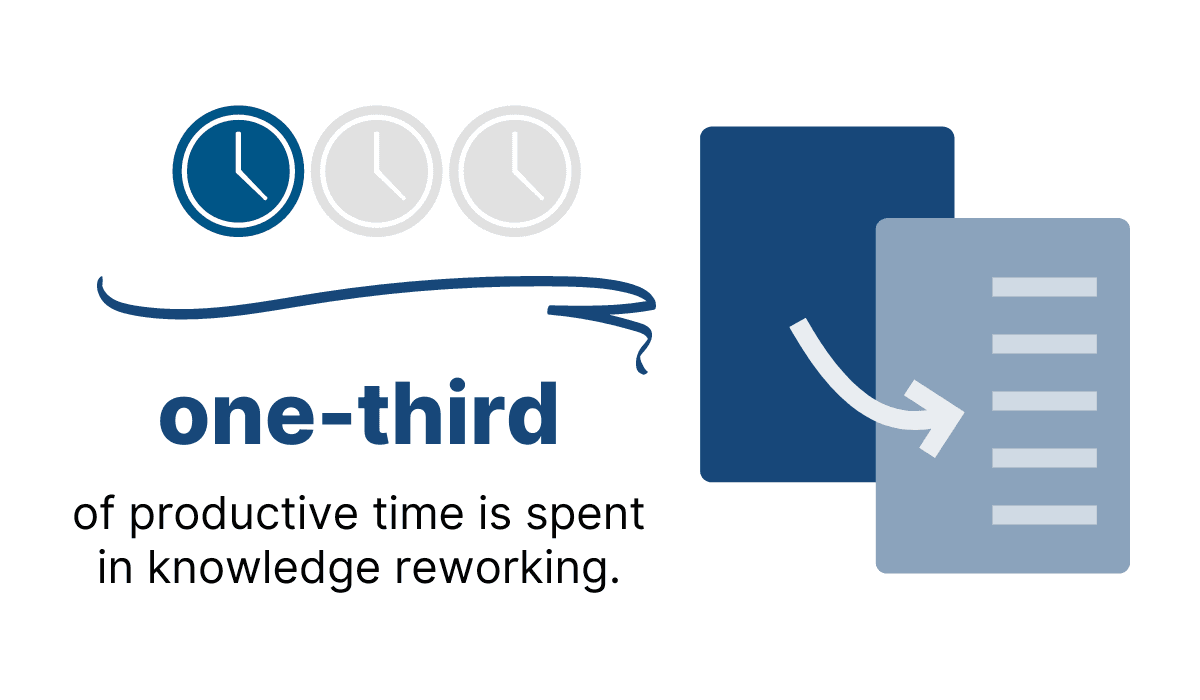
Illustration: Archbee / Source: IDC
Imagine HR asks for the Development department’s organizational chart. Without a knowledge base, you’ll likely search for this document, won’t find it, and then lose time writing it yourself.
About a month later, you’ll probably discover that you had the document but couldn’t find it.
With a knowledge base, you’ll simply search the repository, find the organizational chart, and link it to HR.
The process should take five minutes instead of the alternate multiple-hour procedure.
By consulting an internal knowledge base, you and your employees can instantaneously find the needed information, making for a more productive workday.
Easier Collaboration Between Employees
For an organization to succeed, it requires the combined efforts of several individuals.
Although your developers can build fantastic software, no one would know about it without the marketing team.
However, marketing works best with customer support, which helps by providing insights into your customers’ behavior.
In other words, teams should collaborate; such cooperation drives your company’s success.
The importance of collaboration can even be proven. For instance, a recent study uncovered the following statistic:

Illustration: Archbee / Source: APQC
Cooperation (both within and across teams) is clearly a priority for most companies.
Organizations would be happiest if employees collaborated not only with their team members but also with other departments.
So, how to enable such collaboration? How to encourage it?
Dinesh Paliwal, the former Lead Independent Director at Raytheon Technologies, emphasized some key points:
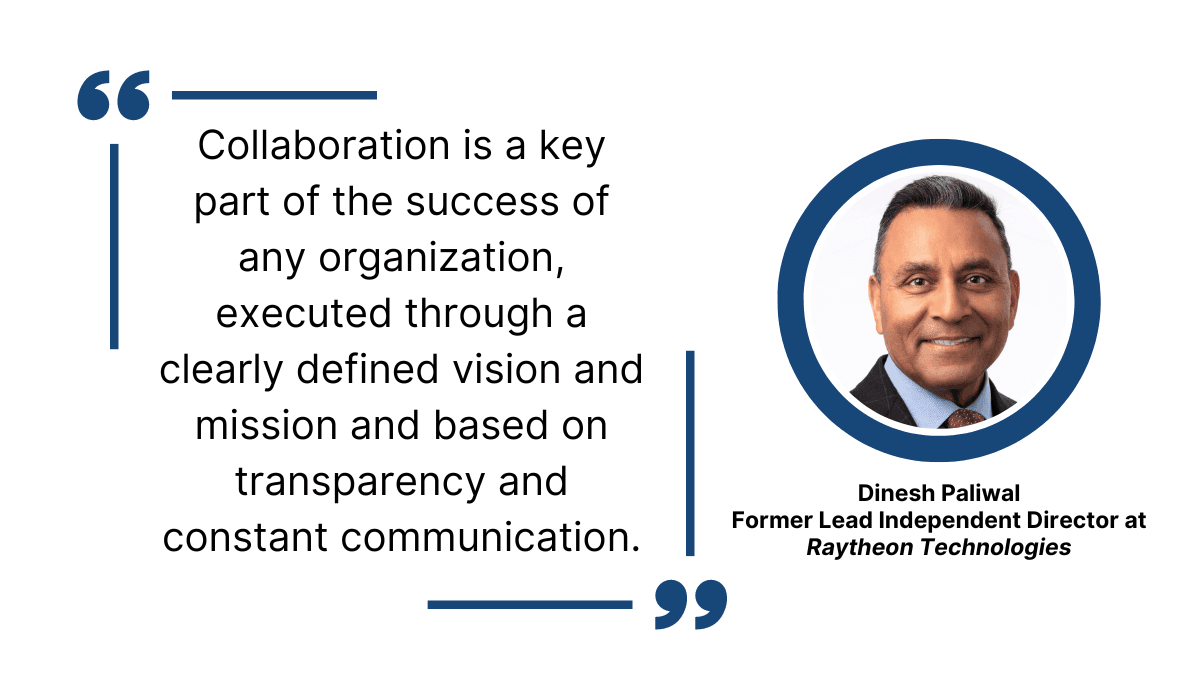
Illustration: Archbee / Source: LinkedIn
Per Dinesh Paliwal, there are three chief prerequisites for effective collaboration: transparency, communication, and a defined vision/mission statement.
Luckily, you can encompass all three elements in your internal knowledge base.
As mentioned, you can use internal knowledge bases to document your company’s goals and mission.
Furthermore, you'll achieve full organizational transparency by having company-wide information available to all employees.
Regarding constant communication, this is easily realized by investing in a documentation tool for maintaining your internal knowledge base.
Documentation tools often come with features designed to facilitate knowledge base use. For example, Archbee offers extensive collaborative functionality.
Here’s one example:

Source: Archbee
With Archbee, if anyone has comments or questions about the knowledge base’s content, they can mention a colleague and start a discussion.
The tool allows team members to deliberate directly inside the internal knowledge base, streamlining communication and cooperation.
Employees can use the knowledge base to see what others are working on, speak about it, and therefore collaborate more easily.
Higher Customer Satisfaction
No matter how sophisticated your software is, your users will inevitably encounter issues. Furthermore, you can also always expect questions regarding product use.
Therefore, to create a great customer experience, superb customer service is a necessity. Your CS representatives need to be product experts.
However, this is easier said than done. One customer service leader told Harvard Business Review the following:

Illustration: Archbee / Source: Harvard Business Review
Customer service (CS) representatives lack the necessary resources to provide high-quality support.
This is worrying; if your employees don’t have the right tools, their efficiency automatically decreases.
So, how can you help your CS employees? What do they need to do their job well?
Gartner might have found the answer:

Illustration: Archbee / Source: Harvard Business Review
You need to somehow effectively deliver knowledge to your CS employees.
The resource they’re missing is information. Equip them with that, and you’ll see tremendous results: response time can be decreased by 80%.
One obvious method of achieving these goals is developing an extensive internal knowledge base. With these resources, they’re sure to provide fast and accurate customer service.
Think about it—a user calls asking about upcoming features or experiencing technical issues.
With an internal knowledge base, your employee can glance at the product roadmap and consult your troubleshooting guides.
All the resources they need are in one centralized location, meaning they’ll find them quickly. Such speedy responses should increase customer satisfaction, as studies have revealed that speed is essential in customer service.
Here are the numbers to prove it:

Illustration: Archbee / Source: Steven Van Belleghem
Considering the importance customers put on quick responses, if you can decrease your response time, you’re sure to have more satisfied customers.
One easy way to reduce this waiting time is to provide your CS representatives with an internal knowledge base.
Conclusion
With an internal knowledge base, you and your employees will always have the exact information you need at your fingertips.
There won’t be any time wasted searching for documents, and you won’t have to contact colleagues to help you.
Instead, a simple search should retrieve the exact intelligence you need, therefore encouraging engagement, productivity, and collaboration.
Having all information readily available makes for a much more pleasant working environment.
If you haven’t developed your own internal knowledge base yet, explain the concept to your colleagues, assemble a team, and start the process—the investment is well worth it.
Archbee can help you create, manage, update and share your knowledge base, along with performing many other tasks based on your needs. Try it yourself using our free trial.
Frequently Asked Questions
An internal knowledge base is your company’s private, searchable source of truth—the place employees go to learn how work gets done and to find reliable answers fast.
What it typically includes:
- SOPs and process docs
- Onboarding guides and the employee handbook
- Product specs, roadmaps, and release notes
- Troubleshooting playbooks and how-tos
- Team directories and org charts
- FAQs, templates, and decision logs
How it works:
- Powerful search, tagging, and linking to surface the right content
- Permissions, review workflows, and version history to keep information accurate and secure
- Integrations with chat, ticketing, and code repos so knowledge shows up where people work
Why it matters:
- Preserves institutional knowledge when people leave
- Speeds up onboarding and day-to-day work
- Aligns teams and improves collaboration
- Equips customer-facing teams with fast, accurate answers that boost satisfaction
